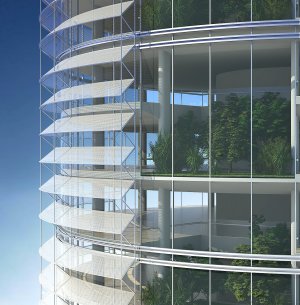Solar shading device for high-rise buildings
Friday, 29 May, 2009
Aims to reduce energy use by 30%
GHD has developed a concept to cut energy use in high-rise buildings.
The external shading system sits like a skin on the outside of a building, moving around on tracks to shield the sun while still allowing daylight to penetrate.

Made from a lightweight frame incorporating photovoltaic cells, the sunshield:
- reduces the energy required to light and cool the building by 30%;
- produces enough energy to power the movement of the shade and provide up to 10% of the building<rsquo;s remaining power needs;
- is made from a simple and cost-effective series of modular panels, which can be removed individually without compromising the whole system; and
- incorporates a guide rail at each floor level to provide both structural support and access for cleaning and maintenance.
The concept was developed through GHD’s innovation program, which invites the company’s 6000 people to submit, collaborate and vote on ideas and provides a transparent, formal process through which their innovation can be recognised and acted on.
The solar shading device was submitted by Martin Hay, Architecture Manager in GHD’s Doha office, and developed and tested in collaboration with the company’s Brisbane and Melbourne offices.
Hay said: “We have estimated that if you mounted the sunshade system on a 40,000 m2 tower, 40 floors high, the shade could reduce CO2 production by 600 tonnes and generate 1000 MWh of power a year.”
The idea spiked interest in the construction industry after Hay presented it at a Building Materials Construction & Technology Congress in Kuwait City.
The sunshade concept has the potential to support sustainability objectives in the Middle East, as well as northern Australia, South-East Asia, Africa and Central and South America.
GHD will conduct in-depth studies with selected manufacturers to refine the concept and explore the potential for transference of electricity generated to the grid, and an integrated water-based cooling system powered by the shield to further reduce air conditioning.
Fluoride boosts water-processed perovskite solar cells
Queensland University of Technology has developed a water processing method to fabricate more...
Multibuild solar installation delivered at City of Playford
Trinasolar partnered with Venergy Solar to deliver a multibuild solar installation across the...
Oracle assists major distributor in clean energy transition
Essential Energy, an electricity distributor in Australia, is said to have modernised its...










